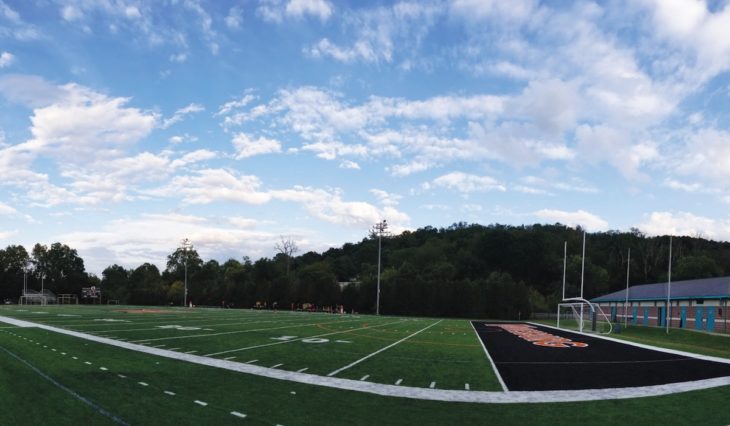 Mitchell Kendra - The Yellow Jacket
Mitchell Kendra - The Yellow Jacket Nine months ago, multiple feet of muddy water laid overtop the field at John F. Wiley stadium. Fast forward to this past weekend, Waynesburg University’s football team ran onto a newly restored turf field to play its home opener.
Flooding this past December rendered the 10-year-old field wrinkled, buckled and useless. Serving as the home field for Waynesburg University athletics, including soccer, football, and lacrosse, university officials began the process of starting constructing on a new playing surface.
Stacey Brodak, vice president for Institutional Advancement and University Relations, served as a spokesperson for the project and said before construction started on a new field, the university formed a committee which included various coaches for input.
“The way the process worked is we formed a committee between athletic coaches and also the business office to be certain they had input on what had been selected and that we were choosing the best materials,” said Brodak.
Field Turf, the same company that put in the original field, was selected out of multiple bids and the committee moved forward with a monofilament and slit filament blend for the new field. Although the overall field design remained original, both end zones were darkened. According to Brodak, the new field is of a higher quality then the original field put in back in 2006.
“[The field is] a synthetic blend between two types of material that we used, which ultimately they felt would be a better-quality field for us,” Brodak said. “I would say in some ways, just due to the 10-year time change, it was a bit of an upgrade to us in addition to being new.”
Construction of a new field, according to Brodak, was originally priced between $400 thousand to $500 thousand. However, Brodak said due to the flooding, the university was able to involve insurance, though it is still being determined to what extent.
According to Brodak, it is estimated insurance will be able to cover a large portion of the cost. Teams are able to get onto the field for games or practices, but the project nor the final expenditure is finalized.
“I did ask the business office and they were a little reluctant to give us a specific date [of completion],” Brodak said. “These things are dependent on both parties reaching an agreement and settling the finality of it.”
In addition to putting in a new turf surface for the stadium, Brodak said there were improvements to the stadium’s drainage in attempt to circumvent future cases of high water.
“One of the things they did want to go in and do was not just lay another field without having some assessment… we ultimately did have a little bit of drainage [improvement] – to help try and prevent [flooding] from happening again,” Brodak said.
Brodak said the overall project went well, though ultimately delayed by two weeks due to a wet summer and a design flaw.
“I think it went pretty smoothly… the only thing we were hopeful of was obviously would have been getting done a little sooner,” Brodak said. “It had a production issue… it was something to do with the color of the imprint on our logo…. [Field Turf] caught it before they ever sent it to us.”
This season the football team will play five games on the field, along with men’s and women’s soccer home games.
